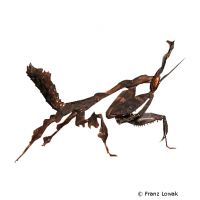Ghost Mantis (Phyllocrania paradoxa)
| Ghost Mantis Phyllocrania paradoxa | |
|---|---|
| Name | Ghost Mantis |
| Name Lat. | Phyllocrania paradoxa |
| Family | Flower Mantids |
| Family lat. | Hymenopodidae |
| Order | Praying Mantids |
| Order lat. | Mantodea |
| Origin | Africa |
| Habitat | Savanna |
| Diet | Flying insects |
| Humidity | 50-60 % |
| Behavior | Predatory |
| Keeping | Individual |
| Care Level | Easy |
| Housing | Dry terrarium |
| Breeding | Moderately difficult |
| Life Span | 8-11 months |
| Protection | No |
| Metric Units | |
| Size | 5 cm |
| Temperature Day | 25-30 °C |
| Temperature Night | 20-22 °C |
| Housing Size | 20 x 20 x 30 cm |
| US Units | |
| Size | 2" |
| Temperature Day | 77-86 °F |
| Temperature Night | 68-72 °F |
| Housing Size | 10" x 10" x 10" |
Distribution and habitat
The range of the diurnal ghost mantis extends over large parts of sub-Saharan Africa from Somalia to South Africa and Madagascar. They inhabit arboreal savannas and sparse dry forests, where they live well camouflaged on trees and bushes.
Maintenance
An insectarium of 20 x 20 x 30 cm (L x W x H) for one animal is recommended. In a larger, richly structured container, pair or group keeping is also possible. An insectarium with a cover made of gauze or a fine metal grid is best suited and should be placed in a quiet place without sunlight.
You need an insectarium not too densely structured with thin, also horizontal climbing branches (hiding places, visual protection) with a cork back wall as well as drought-resistant, large-leaved plants and branches with dry foliage as well as a substrate of sand-earth mixture (terrarium humus) and a small, shallow drinking vessel with water gel or a absorbent cotton drinker. The inside of the insectarium should be lightly sprayed with water every 2-3 days. Too much moisture is not tolerated.
| Temp. day: 25-30 °C | Temp. night: 20-22 °C | Humidity: 50-60 |
The lighting duration should be 12 hrs. Light sources that also produce the necessary heat are ideal.
Diet
They are predatory and seize the prey, preferably flying insects, with lightning speed from an angled lying-in-wait position with their tentacles. The food supply should consist of crickets, house crickets, flies (Drosophila) and grasshoppers, small butterflies and small arachnids. It is important to regularly add minerals and vitamins (e.g. by dusting the feeders). The quality of the feeders can be enhanced by feeding overripe fruit and honey water. A few days before, during and after molting, they refuse to eat. During molting, no predatory feeders (e.g. crickets) should remain in the insectarium, as during this time the animals are unprotected and may become prey themselves.
A varied diet promotes health and prevents deficiency symptoms.
Reproduction and breeding
The sexes can be distinguished by the antennae and the crown on the head. The male's antennae are significantly thicker and longer. The crown is rather straight in the female and s-shaped curved in the male. Males and the slightly bulkier females are almost the same size
About 3 weeks after mating, the female lays up to 10 elongated egg packages (oothecae) at intervals of 6-12 days, usually on branches. After about 4 weeks, at a temperature of about 25 °C and a humidity of about 60-70 %, up to 50 nymphs hatch from each egg packet. The young are only a few millimeters long, black in color, and resemble ants (mimicry). They should be fed immediately with small fruit flies or microheims so that they do not eat each other (cannibalism)
After the imaginal molt, the animals are ready to mate after about 14 days. After that the males live for about 8 months, the females up to 11 months
Important
They have very good camouflage due to their body shape and coloration as well as their often long-lasting motionlessness and with their numerous body appendages they are very similar to a leaf (leaf mimesis).
For molting they hang upside down in the branches or on the lattice cover and slide out of their old cover. Therefore, they need at least one body length of free space below them.
Before purchasing, an insectarium should be prepared that meets the species-specific needs. Good ventilation without drafts is necessary, as well as equipment for measuring temperature and humidity. The lighting must correspond to the day-night rhythm appropriate for the species and must be installed in such a way that the animals cannot injure themselves. The insectarium should be locked in such a way that neither unauthorized persons can open it nor the animals can escape. Special attention must be paid to thorough hygiene and contamination must be removed regularly.
Further literature can be found in your pet store.
References
Text: Serena Werle; Image: Franz Lowak
Source: HENKEL & SCHMIDT (2010): Taschenatlas Wirbellose für das Terrarium, Verlag Ulmer; ENGELMAN & LANGE (2011): Zootierhaltung - Tiere in menschlicher Obhut: Wirbellose, Verlag Harri Deutsch
